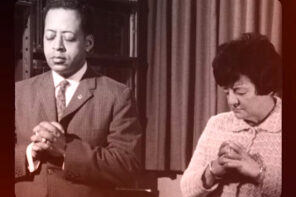This spring Sherry Jones’ The Jewel of Medina was rejected for publication by Ballantine Books. The novel is now at the center of the latest round of controversy about fictionalizing the history of Islam and the lives of Muhammad and his relatives. Media reaction was minimal until the Wall Street Journal picked up the story under the head, “You Still Can’t Write About Muhammad.” The refusal of the publisher to go ahead with the publication of the book, which also involved a contract for a second book, has raised charges of censorship, of caving in to radical Islam, and echoes of the controversy about Salman Rushdie’s Satanic Verses. Just this week the Telegraph reported that the UK publisher of the book is hiding and under police protection after being targeted by extremists. “Why,” many are asking, “can’t we write about, make movies about, or draw cartoons of religious figures such as Jesus, the Buddha, or Muhammad without raising the ire of these ‘overly sensitive’ religious groups? Have religious topics now become off limits for secular art?”
Sherry Jones has since found a US press, Beaufort Books, willing to take the chance on publication, (the same press that published O.J. Simpson’s fictionalized confession), but the story of the book’s rejection, the reaction to that rejection, and its subsequent adoption by a press notorious for courting controversy, does raise some important issues, and they are not simply political. It turns out that what we see here—once we take religion scholarship into account—is not new, not East against West, and not grounded in a defense against, or for, radical or militant Islam.
To begin with, the excerpts that have been released show that the novel is, in the judgment of some scholars of early Islam, neither well-researched nor well-written. One of the modern scholars, whose reading of Jones’ manuscript for the press started much of the criticism, is a professor of early Islam who has written about Aisha (Politics, Gender, and the Islamic Past: The Legacy of Aisha bint Abi Bakr). Denise Spellberg, an Associate Professor at the University of Texas, is reported to have objected to the novel on the grounds that it was historically inaccurate and “soft core porn.” Unlike Sherry Jones, Prof. Spellberg knows the original sources in Arabic and has dealt with the issues of early Arabic sources. As one who has published on the earliest biography of Muhammad and is familiar with those same sources, I contend that it is the form and shape of the early sources and their subsequent use among Muslims that are part of the foundation of the current controversy.
The earliest historical material we have about the beginning of Islam and the lives of Muhammad, his family, and his companions, comes to us in the form of short anecdotes and sayings, called hadîth, that were collected by the early followers of Muhammad for pietistic reasons to enable them to emulate Muhammad’s actions, those of his close companions, and to understand the complexities of Quranic commandments, which are at times ambiguous. Similar to material found in the Rabbinic Jewish Talmud, much of the hadîth material is decontextualized and without clear temporal markings. One cannot easily or often find when an utterance was said or when an action was performed. The actions and sayings of Muhammad, and by extension those of his wives and close companions, were viewed by the early collectors and their readers as universal models for correct behavior. They were not meant to be history but, rather, Heilsgeschichte, “salvation history” —history as it was intended to be, rather than as it might actually have been. This is not to say that that we modern historians cannot find historical “facts” in this material, but finding history takes careful, sophisticated analysis and a recognition of the major limitations of our sources. It was the “salvation history” that was transmitted by the faithful across the generations to today and is known in some form or another by most Muslims who have even a modicum of a religious education. While not “history” in our Western sense, it is the “true” past to millions of Muslims. In the Sunni tradition in particular, the knowledge of the early Islamic world, especially as it is used to promote proper behavior, remains in the anecdotal, atomized form, and should only be put into narrative history by those qualified to do so, the educated, religious elite.
The first attempt to write a full narrative biography of Muhammad was begun toward the end of the first Islamic century and completed shortly after the centenary of Muhammad’s death (632 C.E.). The author, Muhammad Ibn Ishaq, came from a family of hadîth collectors and was a well-regarded traditionist in Medina before he traveled to Iraq to be part of the court of the founder of the Abbasid dynasty. He became the court historian and tutor for the Caliph’s son and heir, and the biography was his textbook. As successful as the biography, known as the Sîrah, or “way” of the Prophet of God, became, it had its strong critics. Ibn Ishaq was accused of leaving things out, of being biased, of not being a rigorous historian, and of writing a heterodox view of Muhammad.
The reasons for these criticisms appear to stem from issues of both genre and control. This was, after all, a narrative, albeit constructed out of the very hadîth that people were circulating orally. It was written down, rather than passed from teacher to pupil in oral lessons, and the narrative biography went directly counter to the growing group of religious scholars, known as ‘alims, whose authority and income depended on people coming to them for authoritative declarations (fatwas) about the relationship of behavior and the biographies of Muhammad and his family. For those familiar with the history of Rabbinic Judaism, this controversy will seem familiar, with the same reluctance to have the religious/legal material of the Talmud written down and available for the interpretations of the non-specialists. (Or think of our modern academic resistance to having our classes videotaped lest we, as teachers, be replaced by recorders and iPods.) As Tzvetan Todorov has shown, narrative has a power of its own, a power that can shape and control the imagination. Only some stories can be let into the canon, and the rest must be kept out. Out of the hundreds of Gospels of Jesus, only a final four were ultimately accepted into the canon, and, for someone like Marcion, or Martin Luther, even those four were problematic.
As we jump ahead to the mid-nineteenth century, glossing over continued debate over how to represent Muhammad’s life and times among Muslims and Christians alike, we encounter another controversy over the writing of a historical narrative about Muhammad. The Scottish Orientalist, Sir William Muir, was a colonial governor of India under the British, founder of Muir College at Allahabad, and author of such works as A Life of Mahomet and History of Islam to the Era of the Hegira. In 1885, he became Principal of Edinburgh University, holding the post until 1903, when he retired. A devout Scottish Presbyterian, his scholarship was influenced by his views that Islam was antithetical to Christianity. The result of his publications was a firestorm of criticism by Muslims writing in the South Asian press against his views, with the result that Western Orientalist scholarship about Muhammad and Islam became synonymous with the colonial domination of South Asians under the British Raj and of Muslims everywhere.
In September, 1988, the novelist and Emory University professor, Salman Rushdie, published the well-known novel, Satanic Verses, a term first coined by William Muir and later picked up by Western Orientalist writers about Muhammad and the Quran. The novel, which has little to do with Islam, used as a subplot a fictionalized reference to an incident that classical Muslim historians and commentators on the Quran say took place in association with the revelation of the fifty-third chapter of the Quran, Surat an-Najm. After receiving and reciting verses 19 and 20 (“Have you considered Allât and al-‘Uzzâ / and Manât, the other third?”), Satan is said to have beguiled Muhammad into adding “These are the exalted cranes (ghar_niq) whose intercession is hoped for.” Such an addition would have seriously attenuated the Quran’s strict monotheism, and the revelation was continued, according to the commentators, rejecting the interpolation, denying the power of the three named pagan deities, and comforting Muhammad by saying that other prophets before him had been thus tempted by the Devil. Book banning and death threats followed immediately, leading to the famous pronouncement of death on Salman Rushdie by the Iranian leader, Ayatollah Khomeini in 1989.
Most of those protesting Salman Rushdie’s novel never read the novel itself or were familiar with the “Crane” issue in the classical Arabic commentaries on the Quran. It was enough that the sacrality of Muhammad and the Quran were “violated” by oblique and fictionalized reference in a novel, in the genre of narrative fiction that is meant to entertain, to play with the imagination—to titillate, rather than to edify.
All of this brings us to Jones’ novel, The Jewel of Medina. From what Jones has said publically, she is not out to denigrate Muslims and paint them in a bad light. Indeed, she told Reuters, “I have deliberately and consciously written respectfully about Islam and Mohammed … I envisioned that my book would be a bridge-builder.” She has said that she wanted to write about Muhammad’s favorite wife, who is known in Sunni Islam as the “Mother of the Believers,” in a way that would make her alive and real to Western readers. (Many Shiites, by the way, have a less favorable view of Aisha, but might object to the Jones story about Aisha as an inaccurate, Sunni portrayal.) From the pre-publication excerpts, Jones has written a “romance” novel, replete with descriptions of sexuality and passion between Aisha and Muhammad. As someone who is not an aficionado of the romance genre, I will leave it to others to judge how well Jones has done.
Islam is not a puritanical religion. It does not reject sex between a man and a woman, and does not extol sexual abstinence as a virtue. Like Rabbinic Judaism, Islamic religious and legal texts are explicit in recognizing human sexuality, including the sexuality of Muhammad and his wives. Avoiding sex and procreation is regarded as against God’s plan for humans. The texts in which the sexuality of Muhammad is mentioned, however, are not works of imagination, like the novel, but works of edification and instruction.
For Muslims who are strongly connected to the story of Muhammad and his family, by belief, culture, or both, this novel is not likely to build a “bridge” between English-reading Westerners and Muslims.




